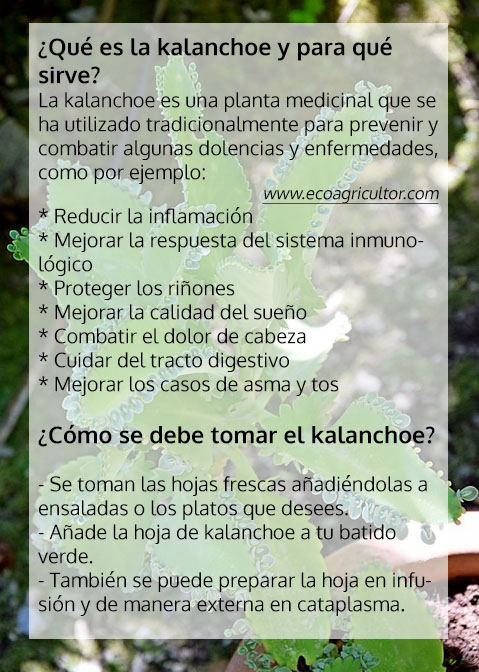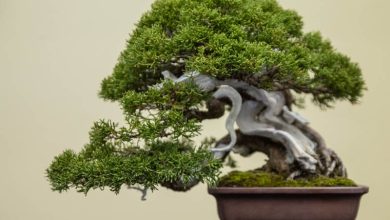Kalanchoe: medicinal plant for diabetes, hypertension, pain or stomach ulcer

Kalanchoe pinnata , Bryophyllum pinnatum , also known by other names such as air leaf , Goethe plant, Ojaransín, arete flower, immortelle, leaflet, tronador or witch’s herb. There are other varieties of this plant such as Kalanchoe gastonis-bonnieri and Kalanchoe daigremontiana .
In this article we are going to talk to you about the properties and benefits of kalanchoe, how it should be taken and what kalanchoe is for. And below you can see a video where I tell you about more properties and proven uses of this medicinal plant.
You will see that kalanchoe is a plant with many medicinal applications. More and more studies are being carried out on this plant and the information we have on its applications in medicine is greater. For example:
Kalanchoe is used to reduce inflammation, improve the response of the immune system, protect the kidneys, improve the quality of sleep, take care of the digestive tract or improve cases of asthma and cough. Although below you can see more uses of the kalanchoe.
This medicinal plant belongs to the Crassulaceae family native to Madagascar and India, forming part of traditional medicine or Ayurveda. Currently it also grows in other places with warm and temperate climates. Kalanchoe is also used in areas of central and southern America for its healing qualities.
It is a plant that can reach a meter in height and has fleshy leaves. The flowers grow in inflorescences and can have different colors such as reddish, yellow or green.

How is kalanchoe used? How to take kalanchoe
Kalanchoe leaves are used for medicinal purposes , which can be prepared to be applied externally or internally.
- For internal use of kalanchoe: it can be prepared in infusion with the dried leaf of the plant. The most common way to use kalanchoe is by adding the fresh leaves to cold or warm dishes such as salads or you can also prepare them to drink the kalanchoe leaf juice alone or add the leaves to green smoothies . The kalanchoe leaf does not have a particularly strong flavor , so it will not alter the flavor of the dish in which you include it, yes, take the leaf fresh and do not cook it.
- For external use, the leaves can be used by making plasters or poultices and the area can also be massaged with the extracted juice after crushing the leaves. For example, for headaches the slightly crushed leaves would be placed on the forehead and nape, or for colic and abdominal pain they would be placed on this area to relieve them.

Properties of the Kalanchoe pinnata, Bryophyllum pinnatum
This medicinal plant has in its composition: phenols, acetates and flavonoids , among some of its components with more remarkable therapeutic action .
Kalanchoe is a medicinal plant with different effects on the body, which provide action:
- Anti-inflammatory
- Hepatoprotective
- Antihemorrhagic
- Anticancer
- Cough suppressant
- Diuretic
- Antihistamine
- Antiseptic
- Antidiabetic
- Antibacterial
- Antalgic
- Antiulcer
- Emollient
- Digestive
- Antiviral
Benefits and medicinal uses of Kalanchoe pinnata
- It is used to combat headaches such as migraine and migraine .

- Protects the liver (hepatoprotective action)
- Decrease inflammation
- Reduce fever
- Relieves respiratory diseases
- It is used to treat cancer cells.
- Kalanchoe is used for coughing
- For bleeding
- Improve slow or heavy digestions with kalanchoe
- It is very useful for stomach ulcers
- It is indicated for diabetics
- Relieves kidney colic.
- Relieves pain in general (analgesic action)
- Improve infections
- Helps reduce hypertension
- It is beneficial in cases of bronchitis
- Fight herpes and other viruses
- It is used to heal wounds on the skin.
- Kalanchoe improves urethritis
- Avoid liquid retention
- Relieves rheumatism
- It is sedative and muscle relaxant
- Cut diarrhea
- It is used to relieve empacho.
- Improves skin conditions
- Accelerates recovery from colds and flu
- Eliminate abscesses
- Kalanchoe is used for measles
- Reduces stomach pain
- Stimulates the functioning of the kidneys
In this wonderful video you can learn more about the properties of the KALANACHOE
Kalanchoe contraindications
The use of this medicinal plant is contraindicated during pregnancy.
It could be contraindicated the consumption of kalanchoe during lactation, consult your midwife or gynecologist before taking any medicinal plant.
This is general information and is not a substitute for medical advice. Consult with a health professional before taking any medicinal plant so that they can offer you the best solution based on your needs and your medical history.



![Photo of How to Plant a Hazelnut and Harvest Your Own Hazelnuts: [Complete Guide]](https://www.complete-gardening.com/wp-content/uploads/2021/06/sembrar-avellanas-390x220.jpg)
![Photo of Ornamental Plants: [Planting, Types, Irrigation and Care]](https://www.complete-gardening.com/wp-content/uploads/2022/08/ornamental-plants-planting-types-irrigation-and-care-390x220.jpg)